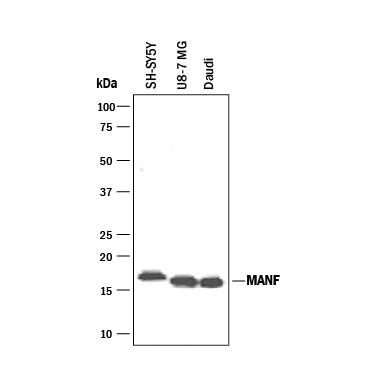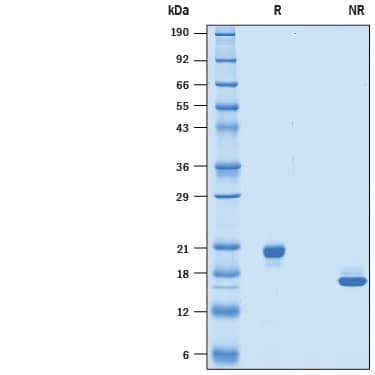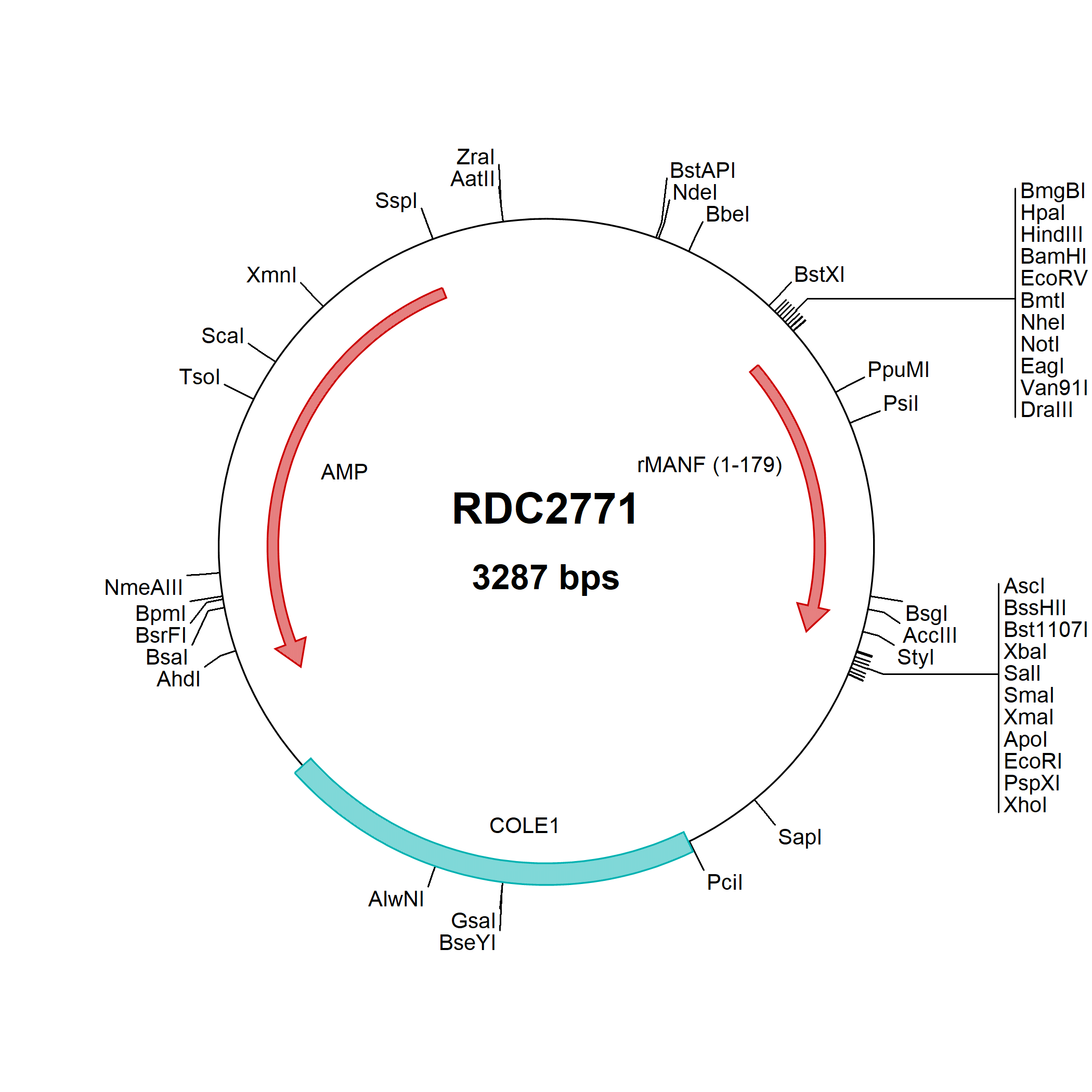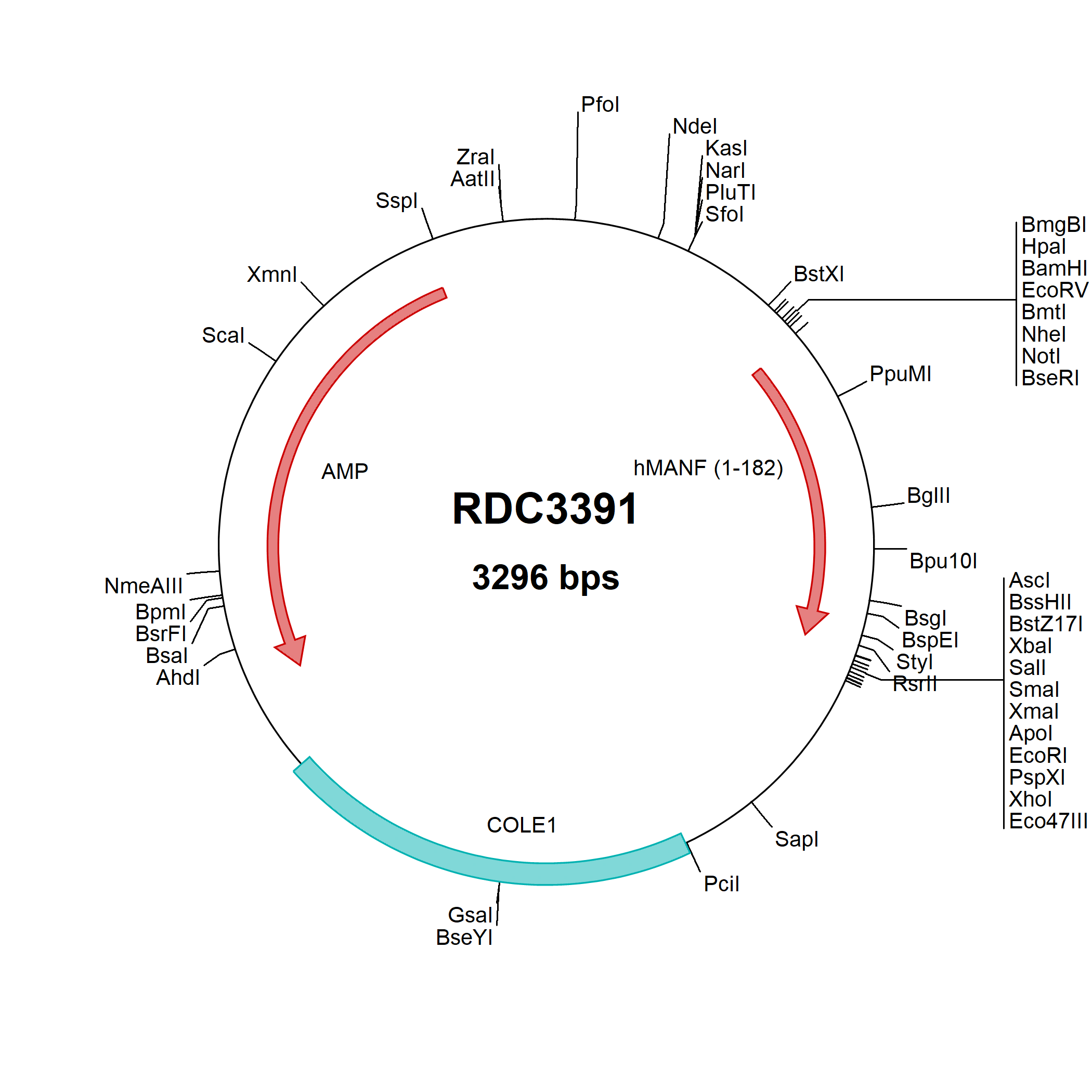MANF Products
Mesencephalic astrocyte-derived neurotrophic factor (MANF), also known as Arginine-Rich, Mutated in Early stage Tumors (ARMET) and Arginine-Rich Protein (ARP), is a 20 kDa member of the ARMET family of proteins. The name ARMET comes from the initial belief that the protein was 50 aa longer at the N-terminus and contained an arginine-rich region. The presence of a specific mutation changing the previously numbered codon 50 from ATG to AGG, or deletion of that codon, has been reported in a variety of solid tumors. Human MANF is synthesized as a 179 amino acid (aa) precursor that contains a 21 aa signal sequence and a 158 aa mature chain. Mature human MANF is 99%, 98% and 96% aa identical to mature rat, mouse and bovine MANF, respectively. MANF is localized to the endoplasmic reticulum (ER) and Golgi apparatus, and is also secreted. In the CNS, MANF selectively protects nigral dopaminergic neurons, versus GABAergic or serotonergic neurons, which suggests that MANF may be indicated for the treatment of Parkinson's disease. MANF is also one of the 12 commonly unfolded protein response (UPR)-upregulated genes. One study showed that MANF plays an important role in protecting cells against tunicamycin and thapsigargin-induced cell death. Loss of MANF renders cells more susceptible to those drugs, but also increases cell proliferation and decreases cell size. Another study showed that MANF is an endoplasmic reticulum stress response (ERSR) gene in the heart that can be induced and secreted in response to ER stresses, including ischemia, and that extracellular MANF may protect cardiac myocytes in an autocrine and paracrine manner.
129 results for "MANF" in Products
129 results for "MANF" in Products
MANF Products
Mesencephalic astrocyte-derived neurotrophic factor (MANF), also known as Arginine-Rich, Mutated in Early stage Tumors (ARMET) and Arginine-Rich Protein (ARP), is a 20 kDa member of the ARMET family of proteins. The name ARMET comes from the initial belief that the protein was 50 aa longer at the N-terminus and contained an arginine-rich region. The presence of a specific mutation changing the previously numbered codon 50 from ATG to AGG, or deletion of that codon, has been reported in a variety of solid tumors. Human MANF is synthesized as a 179 amino acid (aa) precursor that contains a 21 aa signal sequence and a 158 aa mature chain. Mature human MANF is 99%, 98% and 96% aa identical to mature rat, mouse and bovine MANF, respectively. MANF is localized to the endoplasmic reticulum (ER) and Golgi apparatus, and is also secreted. In the CNS, MANF selectively protects nigral dopaminergic neurons, versus GABAergic or serotonergic neurons, which suggests that MANF may be indicated for the treatment of Parkinson's disease. MANF is also one of the 12 commonly unfolded protein response (UPR)-upregulated genes. One study showed that MANF plays an important role in protecting cells against tunicamycin and thapsigargin-induced cell death. Loss of MANF renders cells more susceptible to those drugs, but also increases cell proliferation and decreases cell size. Another study showed that MANF is an endoplasmic reticulum stress response (ERSR) gene in the heart that can be induced and secreted in response to ER stresses, including ischemia, and that extracellular MANF may protect cardiac myocytes in an autocrine and paracrine manner.
| Reactivity: | Human |
| Details: | Goat IgG Polyclonal |
| Applications: | WB, Simple Western, KO |
| Source: | NS0 |
| Accession #: | ACE87065 |
| Applications: | BA |
| Reactivity: | Human, Mouse, Rat |
| Details: | Rabbit IgG Polyclonal |
| Applications: | IHC, WB, ELISA, ICC/IF |
| Reactivity: | Human |
| Details: | Mouse IgG1 kappa Monoclonal Clone #1D10 |
| Applications: | WB, ELISA, ICC/IF |
| Reactivity: | Human, Mouse, Rat |
| Details: | Rabbit IgG Polyclonal |
| Applications: | IHC, WB, ELISA, ICC/IF |
| Reactivity: | Human |
| Details: | Rabbit IgG Polyclonal |
| Applications: | IHC, WB, ICC/IF |
| Source: | NS0 |
| Accession #: | P0C5H9.1 |
| Applications: | BA |
| Reactivity: | Human |
| Details: | Rabbit IgG Polyclonal |
| Applications: | WB, ICC/IF |
| Reactivity: | Human |
| Details: | Goat IgG Polyclonal |
| Applications: | WB, ELISA |
| Reactivity: | Human, Mouse |
| Details: | Rabbit IgG Polyclonal |
| Applications: | WB |
| Applications: | WB |
| Reactivity: | Human, Mouse |
| Details: | Rabbit IgG Polyclonal |
| Applications: | WB |
| Reactivity: | Mouse |
| Details: | Rabbit IgG Polyclonal |
| Applications: | ELISA |
| Reactivity: | Mouse |
| Details: | Rabbit IgG Polyclonal |
| Applications: | ELISA |
| Reactivity: | Human, Mouse, Rat |
| Details: | Rabbit IgG Polyclonal |
| Applications: | IHC, WB, ELISA, ICC/IF |
| Reactivity: | Human, Mouse, Rat |
| Details: | Rabbit IgG Polyclonal |
| Applications: | IHC, WB, ELISA, ICC/IF |
| Reactivity: | Human, Mouse, Rat |
| Details: | Rabbit IgG Polyclonal |
| Applications: | IHC, WB, ELISA, ICC/IF |
| Reactivity: | Human, Mouse, Rat |
| Details: | Rabbit IgG Polyclonal |
| Applications: | IHC, WB, ELISA, ICC/IF |
| Reactivity: | Human, Mouse, Rat |
| Details: | Rabbit IgG Polyclonal |
| Applications: | IHC, WB, ELISA, ICC/IF |
| Applications: | AC |
| Applications: | AC |
| Applications: | AC |
| Reactivity: | Mouse |
| Details: | Rabbit IgG Polyclonal |
| Applications: | ELISA |




![Western Blot: MANF Antibody - BSA Free [NBP1-76836] - MANF Antibody - BSA Free](https://resources.bio-techne.com/images/products/nbp1-76836_rabbit-polyclonal-manf-antibody-271120241939270.gif)
![Western Blot: MANF Antibody (1D10) [H00007873-M01] Western Blot: MANF Antibody (1D10) [H00007873-M01]](https://resources.bio-techne.com/images/products/ARMET-Antibody-1D10-Western-Blot-H00007873-M01-img0002.jpg)
![Western Blot: MANF AntibodyBSA Free [NBP1-76837] Western Blot: MANF AntibodyBSA Free [NBP1-76837]](https://resources.bio-techne.com/images/products/MANF-Antibody-Western-Blot-NBP1-76837-img0005.jpg)
![Western Blot: MANF Antibody [NBP1-90099] Western Blot: MANF Antibody [NBP1-90099]](https://resources.bio-techne.com/images/products/ARMET-Antibody-Western-Blot-NBP1-90099-img0006.jpg)



![Western Blot: MANF Antibody [NBP1-32037] Western Blot: MANF Antibody [NBP1-32037]](https://resources.bio-techne.com/images/products/ARMET-Antibody-Western-Blot-NBP1-32037-img0003.jpg)
![Western Blot: MANF Antibody [NBP1-06020] Western Blot: MANF Antibody [NBP1-06020]](https://resources.bio-techne.com/images/products/ARMET-Antibody-Western-Blot-NBP1-06020-img0002.jpg)
![Western Blot:[NBP3-30386]- MANF Antibody](https://resources.bio-techne.com/images/products/nbp3-30386_rabbit-manf-pab-2312025128844.jpg)
![Western Blot: MANF Overexpression Lysate [NBL1-07719] Western Blot: MANF Overexpression Lysate [NBL1-07719]](https://resources.bio-techne.com/images/products/ARMET-Overexpression-Lysate-Adult-Normal-Western-Blot-NBL1-07719-img0002.jpg)
![Western Blot:[NBP3-30447]- MANF Antibody](https://resources.bio-techne.com/images/products/nbp3-30447_rabbit-manf-pab-231202511585510.jpg)
